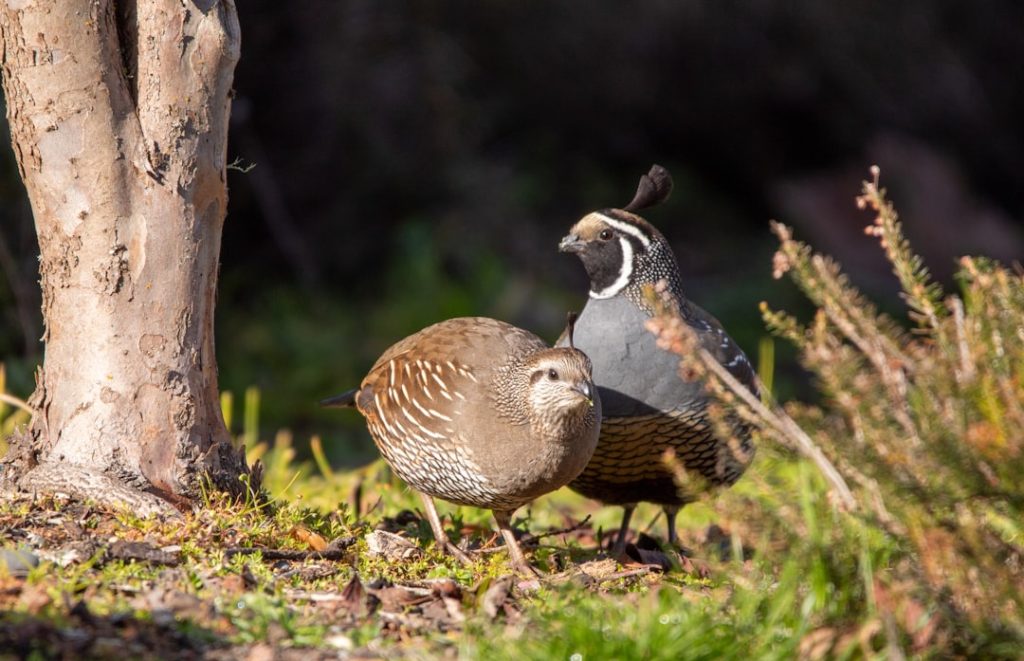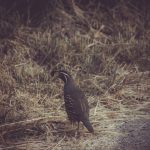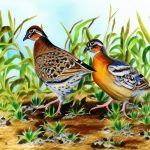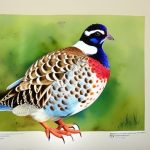Gambel’s quail (Callipepla gambelii) are small, ground-dwelling birds native to the southwestern United States and parts of Mexico. They are named after William Gambel, a 19th-century naturalist who first described the species. These birds are known for their distinctive appearance, with a plume on their head and a scaly pattern on their underparts. They are also recognized for their unique vocalizations, including a distinctive call that sounds like “chi-ca-go.” Gambel’s quail are social birds that typically live in coveys, which are small groups of birds that forage and roost together. They are primarily seed-eaters, feeding on a variety of grasses, herbs, and shrubs, as well as insects and other small invertebrates. Gambel’s quail are also popular game birds and are often hunted for sport and food. Despite this, they are still considered a species of least concern by the International Union for Conservation of Nature (IUCN), as they have a large and stable population.
Gambel’s quail are known for their distinctive appearance and behavior, making them a popular subject for birdwatchers and wildlife enthusiasts. Their unique vocalizations and social nature make them a fascinating species to observe in the wild. Understanding their breeding season and the behaviors associated with it can provide valuable insights into their reproductive biology and population dynamics. In this article, we will explore the breeding season of Gambel’s quail, including their courtship and mating behavior, nesting and egg laying, incubation and hatching, as well as parental care and chick rearing. We will also discuss the impact of the breeding season on population dynamics and the conservation of this iconic species.
Table of Contents
- 1 The Breeding Season of Gambel’s Quail
- 2 Courtship and Mating Behavior
- 3 Nesting and Egg Laying
- 4 Incubation and Hatching
- 5 Parental Care and Chick Rearing
- 6 Impact of Breeding Season on Population Dynamics
- 7 FAQs
- 7.1 What is the breeding season for Gambel’s quail?
- 7.2 How do Gambel’s quail attract mates during breeding season?
- 7.3 Where do Gambel’s quail build their nests during breeding season?
- 7.4 How many eggs do Gambel’s quail typically lay during breeding season?
- 7.5 How long does it take for Gambel’s quail eggs to hatch during breeding season?
Key Takeaways
- Gambel’s quail are small ground-dwelling birds found in the southwestern United States and parts of Mexico.
- The breeding season for Gambel’s quail typically occurs in the spring and early summer, with peak activity in April and May.
- Courtship and mating behavior in Gambel’s quail involves elaborate displays by males to attract females, including calling and strutting.
- Female Gambel’s quail build shallow ground nests and lay clutches of 10-12 eggs, with incubation lasting around 21 days.
- After hatching, both parents are involved in caring for and rearing the chicks, which are precocial and able to leave the nest shortly after hatching.
The Breeding Season of Gambel’s Quail
The breeding season of Gambel’s quail typically occurs in the spring and early summer, coinciding with the availability of food and favorable environmental conditions. During this time, male quail become more vocal and active in establishing and defending territories, while females become receptive to mating. The onset of the breeding season is often triggered by environmental cues such as increasing day length and temperature, which stimulate hormonal changes in both male and female quail. As a result, males begin to display courtship behaviors such as strutting, calling, and chasing females, while females assess potential mates based on their displays and physical condition. The breeding season is a critical period for Gambel’s quail, as it determines the success of their reproductive efforts and the survival of their offspring.
The breeding season of Gambel’s quail is a time of heightened activity and social interactions, as individuals compete for mates and resources. Understanding the timing and dynamics of the breeding season can provide valuable insights into the reproductive ecology of this species and its role in shaping population dynamics. By studying the breeding season of Gambel’s quail, researchers can gain a better understanding of the factors that influence reproductive success and population growth, which can inform conservation efforts aimed at protecting this iconic species.
Courtship and Mating Behavior
During the breeding season, male Gambel’s quail engage in elaborate courtship displays to attract females and establish mating opportunities. These displays often involve puffing up their plumage, erecting their head plume, and strutting around females while emitting distinctive calls. Males may also engage in chasing behaviors to pursue receptive females and deter rival males from approaching. These courtship displays serve to demonstrate the male’s fitness and genetic quality to potential mates, as well as to establish dominance within the social hierarchy. Females assess these displays and choose mates based on their physical condition, vigor, and ability to provide parental care.
Mating behavior in Gambel’s quail typically involves a brief courtship ritual followed by copulation, which occurs quickly and often covertly to avoid detection by predators or rival males. Once a pair has mated, they may engage in mutual preening and other affiliative behaviors to strengthen their bond and reinforce their pair bond. Males may also continue to defend their mates from other males to ensure exclusive access to reproductive opportunities. Understanding the courtship and mating behavior of Gambel’s quail can provide valuable insights into the reproductive strategies and social dynamics of this species, as well as the factors that influence mate choice and reproductive success.
Nesting and Egg Laying
After mating, female Gambel’s quail begin to search for suitable nesting sites where they can lay their eggs and rear their offspring. Nests are typically constructed on the ground, often in concealed locations such as under shrubs or in dense vegetation to provide protection from predators and the elements. Females use a variety of materials to build their nests, including grasses, leaves, and feathers, which they arrange into a shallow depression lined with down feathers to create a soft and insulating environment for their eggs. Once the nest is complete, females begin to lay a clutch of eggs, typically ranging from 10-15 eggs per nest, although larger clutches have been reported in some cases.
The process of nesting and egg laying is a critical stage in the reproductive cycle of Gambel’s quail, as it determines the number of offspring that will be produced and their chances of survival. Female quail invest significant time and energy into building their nests and laying their eggs, as well as incubating them to ensure their development. Understanding the nesting behavior of Gambel’s quail can provide valuable insights into the factors that influence nest site selection, clutch size, and reproductive success, as well as the challenges they face in rearing their offspring.
Incubation and Hatching
Once the clutch is complete, female Gambel’s quail begin the process of incubating their eggs to facilitate embryonic development and prepare for hatching. Incubation typically lasts for about 21 days, during which time females remain on the nest to regulate the temperature and humidity of the eggs, as well as to protect them from predators and disturbances. Incubation is a demanding task that requires constant attention and vigilance from females to ensure the survival of their offspring. During this time, males may continue to defend their mates and nests from potential threats to provide additional protection.
As the incubation period progresses, the eggs begin to hatch, with chicks emerging from their shells over a period of several hours or days. Hatching is an energetically demanding process for chicks, who must use their egg tooth to break through the shell and emerge into the outside world. Once hatched, chicks are precocial and able to move around shortly after birth, although they remain dependent on their parents for warmth, protection, and food. Understanding the process of incubation and hatching in Gambel’s quail can provide valuable insights into the challenges faced by parents in rearing their offspring and the factors that influence chick survival.
Parental Care and Chick Rearing
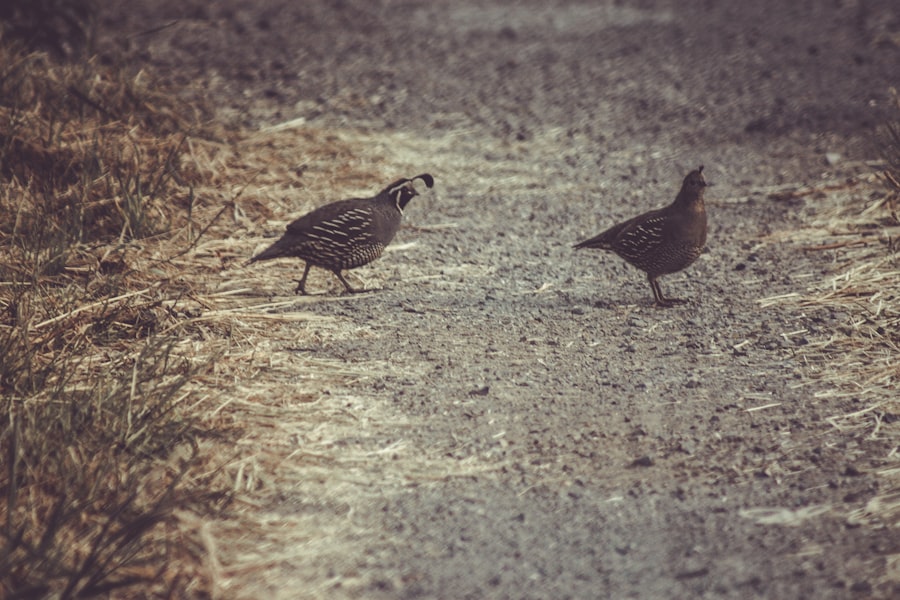
After hatching, both male and female Gambel’s quail play important roles in providing parental care to their offspring. Parents lead their chicks away from the nest site to forage for food and teach them essential survival skills such as finding food, avoiding predators, and navigating their environment. Chicks rely on their parents for protection and guidance during this critical period of development, as they are vulnerable to predation and environmental hazards. Parents also provide warmth and shelter for their chicks by brooding them under their wings or leading them to sheltered areas.
Parental care is essential for the survival of Gambel’s quail chicks, as it provides them with the support they need to grow and thrive in their natural habitat. By studying parental care behaviors in Gambel’s quail, researchers can gain valuable insights into the factors that influence chick survival and population dynamics. Understanding how parents invest time and energy into rearing their offspring can inform conservation efforts aimed at protecting this iconic species and ensuring its long-term viability in the wild.
Impact of Breeding Season on Population Dynamics
The breeding season plays a critical role in shaping population dynamics for Gambel’s quail, as it determines the number of offspring produced each year and their chances of survival. Factors such as environmental conditions, food availability, predation pressure, and habitat quality can all influence reproductive success and population growth. Understanding how these factors interact during the breeding season can provide valuable insights into the challenges faced by Gambel’s quail in maintaining viable populations.
The impact of the breeding season on population dynamics can also have broader implications for conservation efforts aimed at protecting this iconic species. By studying how reproductive success varies across different habitats and environmental conditions, researchers can identify key areas for conservation action and prioritize efforts to protect critical breeding habitats. Understanding how population dynamics are influenced by the breeding season can inform management strategies aimed at mitigating threats such as habitat loss, predation, climate change, and human disturbance.
In conclusion, the breeding season is a critical period in the life cycle of Gambel’s quail that influences their reproductive success, parental care behaviors, chick survival, and population dynamics. By studying the breeding season of Gambel’s quail, researchers can gain valuable insights into the factors that influence their reproductive biology and inform conservation efforts aimed at protecting this iconic species for future generations to enjoy.
As Gambel’s quail breeding season approaches, it’s important to understand the mating and egg-laying behaviors of other poultry as well. For example, if you’re interested in learning about the egg-laying habits of guinea fowl, you might find this article on when guinea fowl lay eggs to be informative. Understanding the breeding and mating seasons of different birds can provide valuable insights for poultry enthusiasts.
FAQs
What is the breeding season for Gambel’s quail?
The breeding season for Gambel’s quail typically occurs from March to September, with peak breeding activity in the spring and early summer months.
How do Gambel’s quail attract mates during breeding season?
Male Gambel’s quail attract mates by performing elaborate courtship displays, including calling, puffing up their feathers, and performing a “bobbing” motion to impress females.
Where do Gambel’s quail build their nests during breeding season?
Gambel’s quail build their nests on the ground, typically in dense vegetation or under shrubs to provide protection for their eggs and chicks.
How many eggs do Gambel’s quail typically lay during breeding season?
Female Gambel’s quail can lay anywhere from 10 to 15 eggs in a single clutch, with an average of 12 eggs being common during the breeding season.
How long does it take for Gambel’s quail eggs to hatch during breeding season?
Gambel’s quail eggs typically take around 21 days to hatch, with both the male and female taking turns to incubate the eggs during the breeding season.
Meet Walter, the feathered-friend fanatic of Florida! Nestled in the sunshine state, Walter struts through life with his feathered companions, clucking his way to happiness. With a coop that’s fancier than a five-star hotel, he’s the Don Juan of the chicken world. When he’s not teaching his hens to do the cha-cha, you’ll find him in a heated debate with his prized rooster, Sir Clucks-a-Lot. Walter’s poultry passion is no yolk; he’s the sunny-side-up guy you never knew you needed in your flock of friends!

